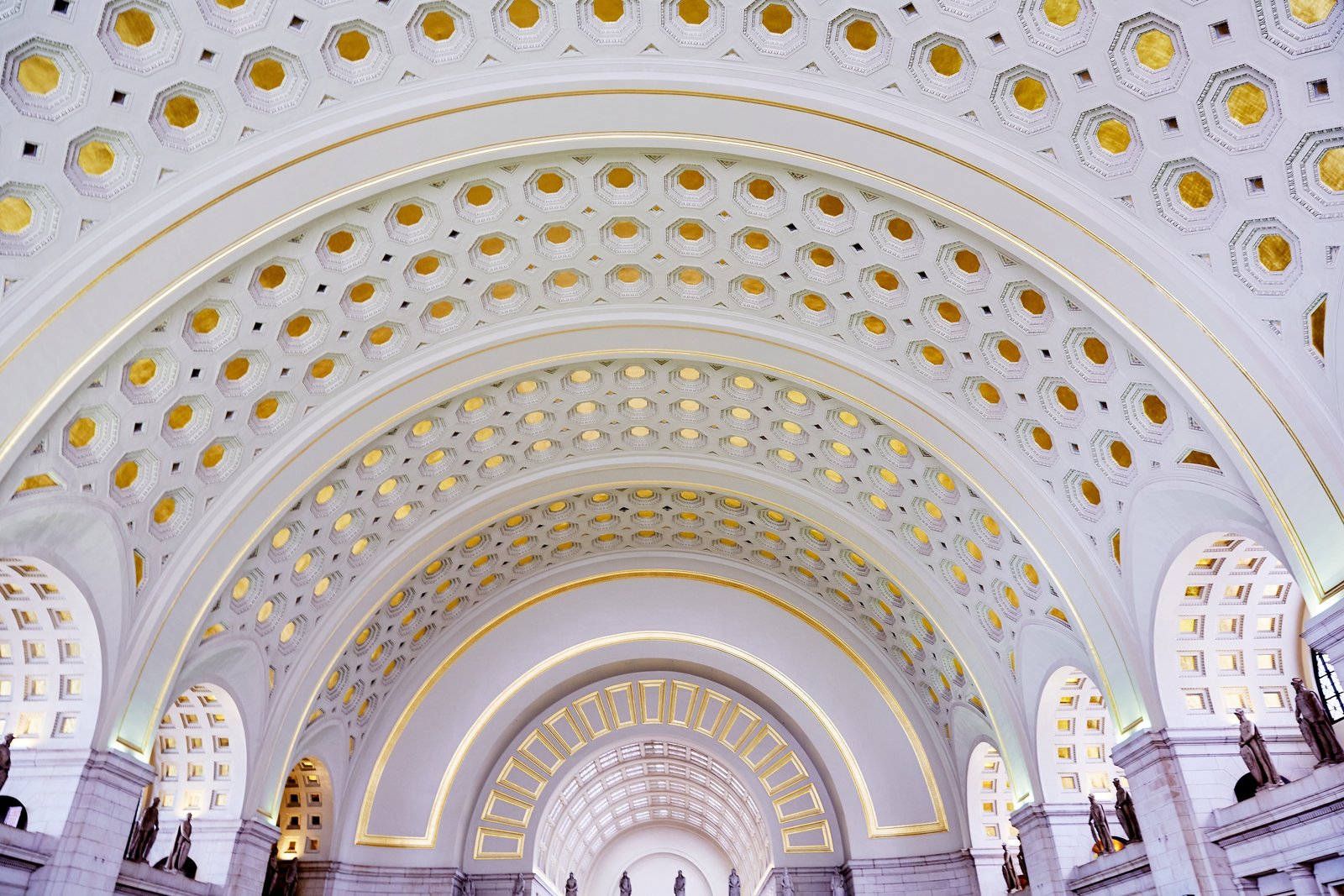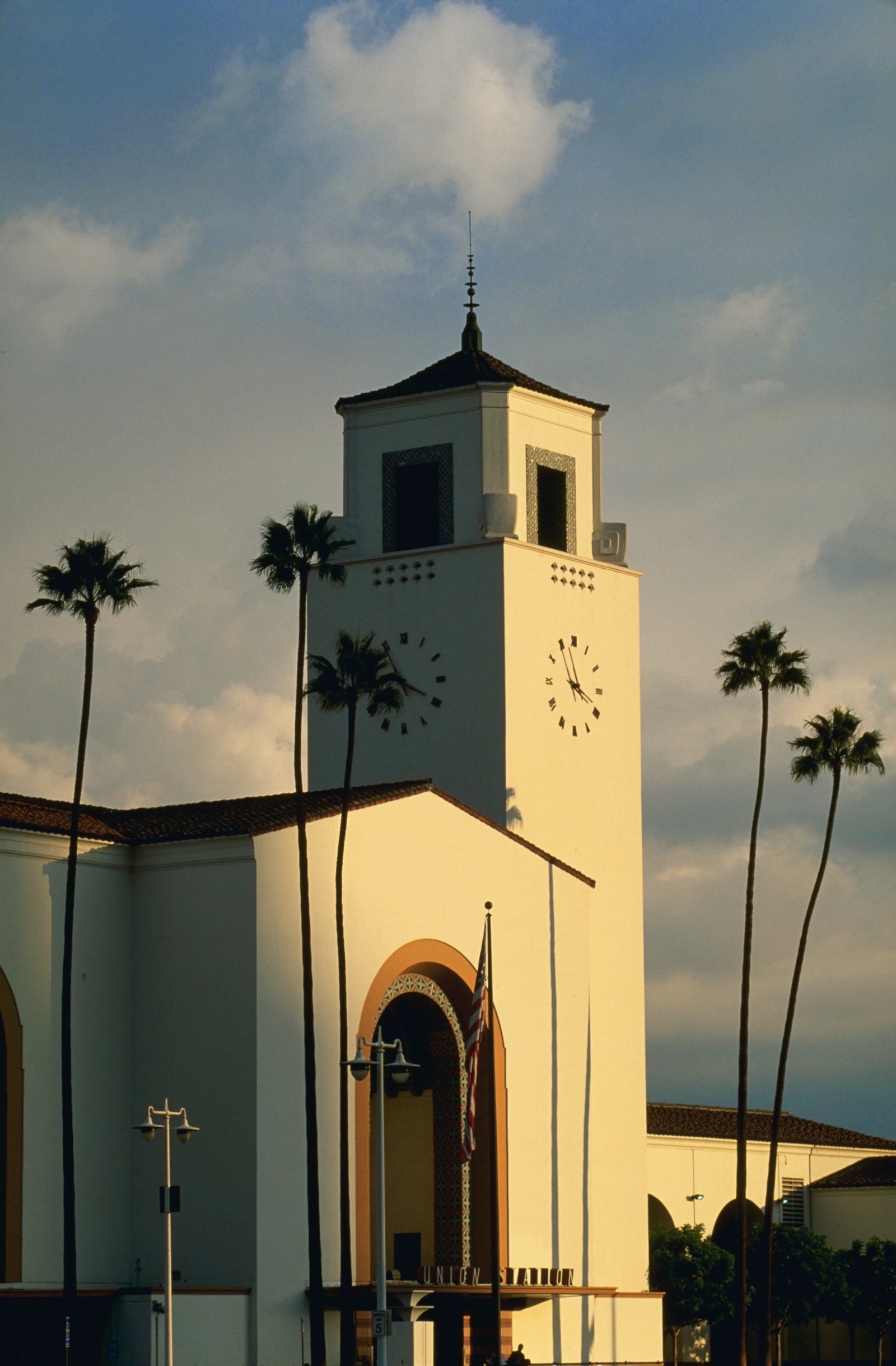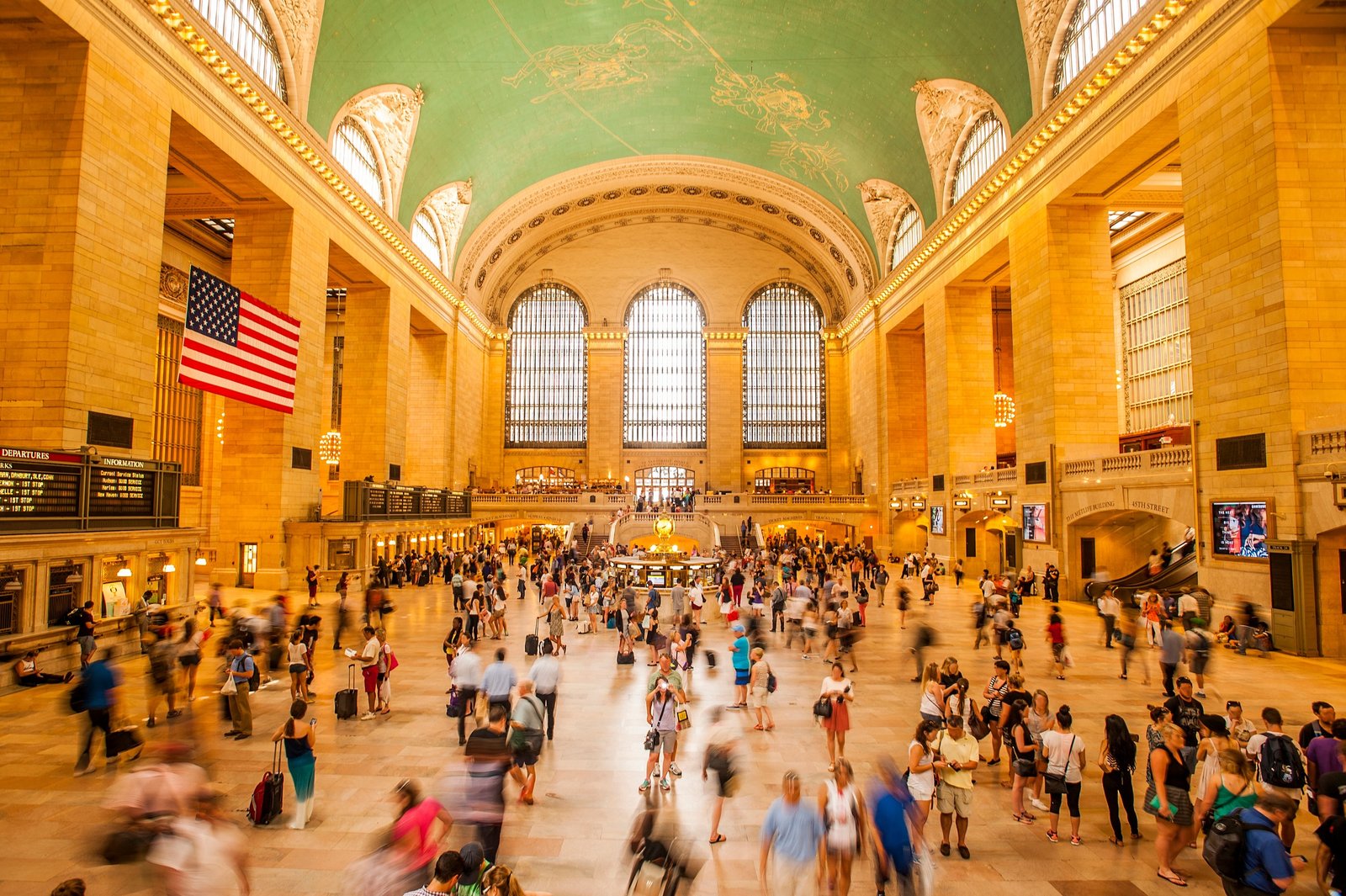Train stations in the U.S. are more than just destinations for passengers to ride the rails—many are historic design marvels—and still are, visitors’ first introduction to major cities like LA, Chicago, and New York City. Communities saved several of these century-old stunners, which had declined after World War II. Now, many train stations now double as hotels, museums, and food halls in addition to serving as transportation hubs. These train stations also remain icons of architecture, and they are starting to see more passengers walk through their doors, too, as Amtrak had a record 32.8 million riders in 2024.
The old-school opulence of these train stations, which drip with marble, mosaics, sculptures, and symbolism, still persuades travelers to pause for a rare taste of architectural eye candy—not something you’d usually say about an airport.
Here’s a list of where you will find the most beautiful train stations in the U.S.
(Travel delays? These airports and train stations actually have great food)
Union Station, Washington, D.C.

Passengers catching trains at Union Station in Washington, D.C., should take in the multi-billion-dollar renovations underway, including the updated 30-foot-high coffered barrel-vaulted ceiling.
Photograph by Allan Baxter, Getty Images
You can’t help but stop in your tracks in Washington, D.C.’s Union Station, a Beaux Arts behemoth completed in 1908 that’s a fittingly grand gateway to the nation’s capital. Its soaring Main Hall has a 30-foot-high coffered barrel-vaulted ceiling punctuated with 23-karat gold-leaf medallions, and 46 statues of ancient Roman Legionnaire soldiers stand sentinel around the room above the passengers wandering below. Despite all these symbols of its past, the station is undergoing a huge $8.8 billion modernization upgrade to transform the country’s second-busiest train station into a hub for high-speed rail. A new train hall is currently under construction next to the historic one, designed to better connect with buses and other forms of public transit.
(Forget the road trip—these national parks are best visited by train)
Denver Union Station, Colorado
Denver’s train station is a phoenix, rising from the ashes—both literally and figuratively—several times over the last century. The chandelier in the women’s bathroom caught fire in 1894, torching most of the original building, but in 1914, the train station expanded to accommodate an increasing number of passengers. An impressive 2014 overhaul brought the formerly dilapidated station back to life, and 10 years later, a refresh confirmed Union Station’s place as an integral part of the city’s fabric. The carved granite Beaux Arts beauty still has many original features, including its terrazzo floors, iron arches, and double-height arched windows.
Today, Denver’s Union Station is a model for other train stations across the country, providing necessities for modern-day travelers. Its food hall contains bars serving cocktails and Colorado craft beers, as well as restaurants, including Iberian-themed Ultreia, helmed by James Beard-award-winning chef Jennifer Jasinski. The Great Hall doubles as a lobby for waiting passengers and guests to check into the luxurious Crawford Hotel, one of only three hotels in Denver awarded a Michelin Key.
“You can’t build history,” says Ed Blair, the area general manager of Denver Union Station. “There are a lot of great new modern spaces, but the uniqueness of Denver Union Station and other train stations throughout the country is that it just happens over time. Keeping those stories alive, whether they be spoken through the architecture that’s restored and celebrated, or whether things are found and turned into art, is part of what’s differentiated us, certainly in the city and then among our peers throughout the country.”
(Is this classic train odyssey through the Rockies North America’s best rail journey?)
Kansas City Union Station, Missouri
“When you walk in and see the towering 95-foot ceilings, it’s kind of like our Sistine Chapel,” says George Guastello, the CEO of Kansas City’s Union Station. The architecture of this train station certainly does inspire feelings of reverence and awe. Opened in 1914, Union Station features heavy bronze doors and a coffered ceiling holding aloft three 3,500-pound chandeliers and a clock with a six-foot-tall face.
Union Station in Kansas City experienced a period of decline after World War II; however, a historic bi-state sales taxthat started in 1997 saved it and helped fund its much-needed renovations. The space has expanded to handle much more than trains. It is also home to a kid-focused science museum, a planetarium, restaurants, and a movie theater with a five-story-tall screen. The station is, of course, still for travelers, but it’s become more like the front porch of Kansas City.
“We’ve become the visual voice of the community,” Guastello says. “I don’t think [architect] Jarvis Hunt could have ever imagined 350,000 people in front of Union Station to do a football draft, but his building was lit up and was the backdrop for one of the biggest sporting events in the world.”
(These are the best train trips in the world to take in 2025 and beyond)
Chicago Union Station, Illinois
Marking its centennial this year, Chicago’s Union Station is the central hub for long-distance train travel in the U.S. As the longtime home of architect Frank Lloyd Wright and the world’s first skyscraper, Chicago is an excellent destination for architecture enthusiasts. Even in a city of giants, Union Station is no slouch, and its humbly named Great Hall hints at the grandeur inside.
“It wasn’t just for travel that locals came to Chicago Union Station. It was a destination in its own right,” say Joan Johns, who leads Union Station tours at the Chicago Architecture Center. “Locals continue to come by Chicago Union Station at all seasons of the year just to visit the Great Hall.”
After a $22 million renovation that wrapped up in 2019, the Great Hall is once again looking its best, boasting travertine columns, hexagonal medallions, and gilded statues called Night and Day—meant to remind customers that trains ran around the clock in the 1920s, unlike air travel at the time. The curved skylight that spans the full length and width of the Great Hall’s ceiling is the highlight at this station.
(10 of the dreamiest stargazing trains in the U.S.)
Los Angeles Union Station, California

Los Angeles Union Station, known for its Mission Moderne architecture, is the last grand train station constructed in the U.S.
Photograph by Robert Landau, Getty Images
The last grand train station constructed in America, Los Angeles Union Station, is the largest train terminal in the western U.S., and was touted as a beacon of modernity when it opened in 1939. Its unique Mission Moderne architecture—combining Spanish Colonial Revival with Art Deco—is embodied in the exterior whitewashed walls, a 127-foot-high clock tower, and a bright red clay tile roof. Inside, the Waiting Hall is an Art Deco masterpiece, featuring a painted beamed ceiling, 30-foot-tall windows, and six 3,000-pound bronze chandeliers above blocky, original wooden chairs. An eight-year-long restoration reveals a ceiling with stencils of California wildflowers in the Entry Vestibule, which had been hidden for 80 years beneath tobacco tar and dirt.
Like many LA residents, Union Station is also a star of the silver screen, having appeared in 150 movies in its long career, including The Dark Knight Rises, Catch Me If You Can, and Blade Runner.
(How to plan the ultimate U.S. rail trip along the West Coast or Eastern Seaboard)
Philadelphia 30th Street Station, Pennsylvania
Travelers are sure to spend a lot of time craning their necks at Philly’s huge train station, where Art Deco meets neoclassical in a truly grand fashion. “It was built at the scale of the great city, with gigantic east- and west-facing Corinthian porticoes appropriate for their function as the gateway of a metropolis,” says David Brownlee, a professor of the history of art at the University of Pennsylvania and an expert on the City Beautiful movement, a turn-of-the-century push to bring beauty and monumental architecture to urban spaces. “The stupendous Main Hall, floored in marble and walled in travertine, is 95 feet tall. It signals to the arriving traveler, in no uncertain terms, that Philadelphia is a place of superlatives.”
Coffered ceilings feature blocky, cylindrical Art Deco chandeliers, and massive windows that span multiple stories, illuminating the space. The station is undergoing a renovation project, expected to finish in 2027, which will brighten its Alabama limestone facades and introduce a new food hall for travelers, making the station a more attractive destination.
Grand Central Terminal, New York

Travelers pass through the busy Grand Central Terminal in New York City.
Photograph by Brian Drouin, National Geographic Image Collection
No U.S. train station is more iconic or better known than Grand Central in New York City. Even though this station doesn’t have Amtrak services—it’s a stop only for some NYC subway lines and regional commuter trains—it sees more than 750,000 passengers every day. Another Beaux-Arts beauty, Grand Central draws its architectural inspiration from ancient Roman baths, and features a vaulted plaster ceiling painted with the 12 constellations of the zodiac and 2,500 stars in gold leaf. Dating from 1913, the bulging glass clock atop the information booth remains a popular meeting point. An acorn sits atop the information booth clock in the Main Concourse. Look closely to find more scattered around the station’s architecture, representing the phrase “great oaks from little acorns grow,” the family motto of the Vanderbilts, who paid for the station’s construction.
Portland Union Station, Oregon
Topped with a 150-foot Romanesque Revival clock tower and an illuminated neon sign that implores travelers to “Go By Train,” Portland’s Union Station opened in 1896 and has been a landmark ever since. It doesn’t resemble the other grand stations from this era, swapping Beaux Arts for brick, but it is the oldest major train station on the West Coast. Today, passengers still wait for departures on large wooden pews under the lofty coffered ceilings, which are adorned with flower-shaped medallions and surrounded by Italian marble walls and floors in the main hall.
Why are so many train stations in the U.S. called Union Station?
In the days when multiple companies provided passenger rail service in the United States, they often pooled their resources to create a single train station in a city. As a way to represent this corporate collaboration, train stations were called Union Station. Today, Amtrak, founded in 1971, is the only national passenger rail service in the U.S.
(After 20 years, Amtrak’s Gulf Coast train line is back—here’s what to expect)
Lauren Keith is a travel writer and guidebook author who covers underloved and off-the-beaten-track places. Follow her on Instagram.


